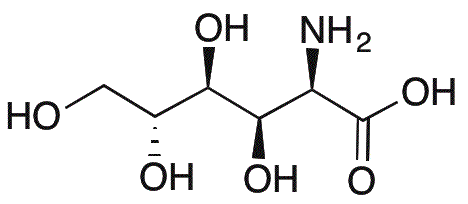D-Glucosaminic acid is widely utilized in research focused on:
- Pharmaceutical Development: This compound is crucial in developing drugs targeting joint health, as it plays a role in cartilage formation and repair.
- Cosmetic Formulations: It is used in skincare products for its moisturizing properties, helping to improve skin hydration and elasticity.
- Food Industry: D-Glucosaminic acid serves as a dietary supplement, promoting joint health and potentially alleviating symptoms of osteoarthritis.
- Biotechnology: Researchers utilize it in cell culture media to enhance cell growth and viability, particularly in studies involving cartilage and connective tissues.
- Research on Glycosaminoglycans: It is essential in studying glycosaminoglycans, which are vital for understanding various biological processes and developing new therapeutic strategies.
General Information
Properties
Safety and Regulations
Applications
D-Glucosaminic acid is widely utilized in research focused on:
- Pharmaceutical Development: This compound is crucial in developing drugs targeting joint health, as it plays a role in cartilage formation and repair.
- Cosmetic Formulations: It is used in skincare products for its moisturizing properties, helping to improve skin hydration and elasticity.
- Food Industry: D-Glucosaminic acid serves as a dietary supplement, promoting joint health and potentially alleviating symptoms of osteoarthritis.
- Biotechnology: Researchers utilize it in cell culture media to enhance cell growth and viability, particularly in studies involving cartilage and connective tissues.
- Research on Glycosaminoglycans: It is essential in studying glycosaminoglycans, which are vital for understanding various biological processes and developing new therapeutic strategies.
Documents
Safety Data Sheets (SDS)
The SDS provides comprehensive safety information on handling, storage, and disposal of the product.
Product Specification (PS)
The PS provides a comprehensive breakdown of the product’s properties, including chemical composition, physical state, purity, and storage requirements. It also details acceptable quality ranges and the product's intended applications.
Certificates of Analysis (COA)
Search for Certificates of Analysis (COA) by entering the products Lot Number. Lot and Batch Numbers can be found on a product’s label following the words ‘Lot’ or ‘Batch’.
Número de catálogo
Número de lote/lote
Certificates Of Origin (COO)
This COO confirms the country where the product was manufactured, and also details the materials and components used in it and whether it is derived from natural, synthetic, or other specific sources. This certificate may be required for customs, trade, and regulatory compliance.
Número de catálogo
Número de lote/lote
Safety Data Sheets (SDS)
The SDS provides comprehensive safety information on handling, storage, and disposal of the product.
DownloadProduct Specification (PS)
The PS provides a comprehensive breakdown of the product’s properties, including chemical composition, physical state, purity, and storage requirements. It also details acceptable quality ranges and the product's intended applications.
DownloadCertificates of Analysis (COA)
Search for Certificates of Analysis (COA) by entering the products Lot Number. Lot and Batch Numbers can be found on a product’s label following the words ‘Lot’ or ‘Batch’.
Número de catálogo
Número de lote/lote
Certificates Of Origin (COO)
This COO confirms the country where the product was manufactured, and also details the materials and components used in it and whether it is derived from natural, synthetic, or other specific sources. This certificate may be required for customs, trade, and regulatory compliance.

